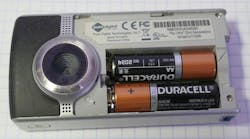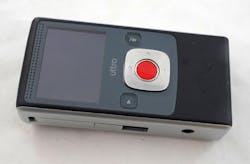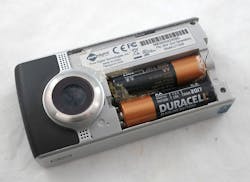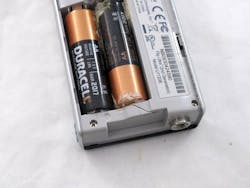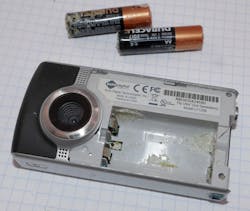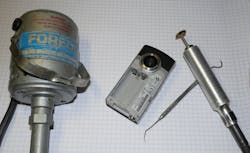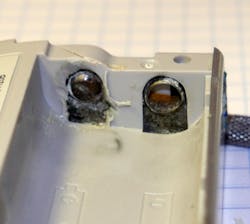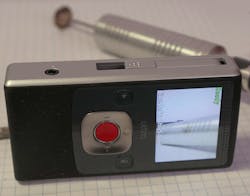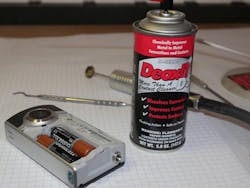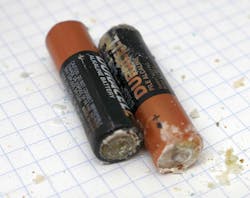The Flip Camera (Fig. 1) was a small simple flash-memory camera with a flip-out USB connector that you could connect to your computer. This model is the Flip Video Ultra II that shoots two hours of SD (standard definition, 640x480) video. I used it to record interviews and conference proceedings years ago. Now I use it to record insert shots for my YouTube videos.
1. The Flip video camera was produced by Pure Digital in the late 2000s. Cisco bought the company and subsequently closed it in 2011.
After leaving it unused for a few years, I was dismayed to see that the Duracell batteries had leaked badly (Fig. 2). I could have understood this if the camera was stored in my Florida garage, where temperatures reach 120°F. But it was in an air-conditioned home the entire time.
2. This Flip Ultra II model has been damaged by leaking Duracell batteries.
The batteries had not only leaked and corroded, they swelled in size (Fig. 3). The swelling was so severe that it cracked the case of the camera. This was a severe problem since that crack reduced the spring pressure on the contact terminals to the batteries. I blame Duracell for making leaky batteries, but I blame the Flip designers for not understanding the structure needed for a battery compartment.
3. The right-hand battery cell has swelled to the point where it cracked the case.
Removing the batteries showed serious corrosion in the battery compartment (Fig. 4). The corroded terminals were a concern, but so were the chunks of alkali leakage that may have dropped inside the unit, where it could ruin the printed circuit board (PCB).
4. The battery compartment has alkali residue that has also fallen inside the case.
Grinding Corrosion to a Halt
I cleaned the battery compartment, then got out a dental tool and my Foredom die grinder (Fig. 5). I bought this die grinder in the 1980s, when I was a consultant in Silicon Valley. It’s ideal for all kinds of rework and prototype fabrication. I guess you can use a Dremel tool, but this was the model I saw used at Teledyne and HP and TRW. I was especially excited to haul it out since I had just replaced the cable sheath and core that twisted off an end after all these years. I like products you can fix decades after you buy them. I put a small brass brush in the chuck, to get the battery terminals clean and polished.
5. A Foredom die grinder with a brass brush is ideal to clean the battery terminals.
The die grinder made quick work of the corroded battery terminals (Fig. 6). I got a bit aggressive; you can see where I ground the plastic away. Its shiny where the batteries touch, but I am concerned about the corrosion I could not get to, extending down inside the case.
6. The die grinder melted a little plastic, but it got the contacts down to good metal.
I popped new batteries in the camera and did a quick test (Fig. 7). I feared the crack in the case would mean the batteries would not make contact. But so far, the camera works fine. Well, other than having a power-off time-out that’s way too short, but that’s a programming problem, not a hardware problem.
7. The Flip camera started working fine, you can see the simple interface with an indication of time remaining.
Once I was sure the camera worked again, I sprayed DeoxIT D5 contact cleaner on the battery terminals (Fig. 8). My ham buddies and pals that fix old test equipment tipped me off about DeoxIT. I have the D5 can I got online, and the GS5-6 for gold-plated contacts that I picked up at Radio Shack.
8. DeoxIT D5 contact cleaner protects the terminals from further corrosion.
Battery Assault
The leaky batteries were in terrible shape (Fig. 9). Worse yet, I have had many other instances of Duracell batteries leaking and ruining valuable equipment. I wrote an article about fixing two Fluke digital voltmeters (DVMs) recently. Commenter cmq0 noted, “Your first mistake was using Duraleak batteries. I've switched to Panasonic batteries purchased from Digi-key (Digi-key has really good pricing on batteries, including coin cells). Too early to tell if the Panasonic batteries are any better, but so far no leaks in a year.”
9. The Duracell batteries seemed to have leaked from every junction.
Another commenter, Art Zinn noted, “... alkaline [batteries] of any maker today seems to be poorly made and leak-prone compared to 20 years ago. Since 2007, I have replaced all alkaline [cells] we use to LSD [low self-discharge] NiMH.” Zinn mentioned that you can spray vinegar around the corroded contact area to neutralize the KOH (potassium hydroxide). He also noted an article on how to re-plate nickel onto contact terminals, as well as a Digi-Key link to replacement contacts.
I see Digi-Key has NiMH batteries, too. Be sure to buy the button top style that works in battery holders of most products. The flat-top design may not touch the terminals. I was astonished to see some NiMH cells have 2.5-Ah capacity. The datasheet for the Panasonic alkaline battery does not give an amp-hour rating, but the discharge curve implies about 2.4 Ah with a 43-Ω load (Fig. 10). Digi-Key charges 31 cents each for 10. The cheapest Panasonic NiMH battery is $3.57. I am inclined to just buy the alkaline disposable battery. I note that datasheet gives a 7-year shelf rating. The battery label says “Not for retail trade.” This is the good stuff, I love it.
10. The Panasonic AA alkaline battery datasheet has several discharge curves, like this one at 43 Ω load.
SourceESB shows the Panasonic alkaline battery is available at Arrow, Mouser, Future, and other distributors, with the same great pricing. I checked at Amazon, and you have to buy 24 cells at twice the price. Whenever I order from Digi-Key, Newark, or Mouser, I check a list of stuff I need for my lab. Banana jacks, coax leads, chemicals, circuit boards, and such. It’s also good to look at any specials on the home page, and there’s always some demo kit that interests me:
That gets the price up to a decent amount where the shipping is fairly negligible.
This Flip camera is about the fifth expensive thing I own with leaky Duracell batteries. You can bet from now on there will be Panasonic or Fujitsu or some other brand in all my electronics. I will debate the economics of alkaline vs. NiMH and try to standardize; I already have several AA chargers. I might even make a sacrifice for the greater good and put one Duracell and one Panasonic battery in a product and then put it in a sweltering garage for a year. If one brand leaks and the other doesn’t, that’s all the proof I need to institute a new battery policy. Let us know what your policy is in the comments.
